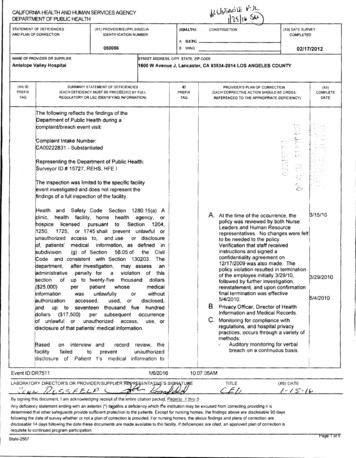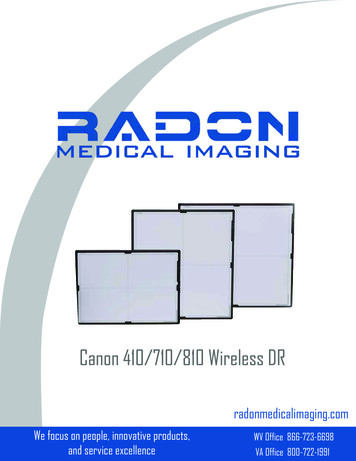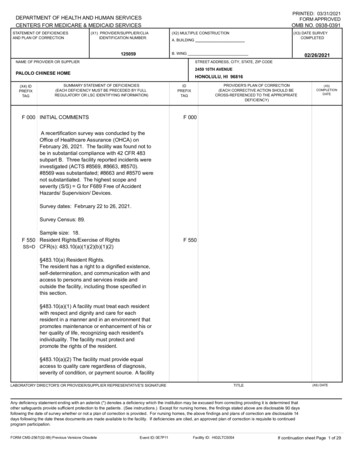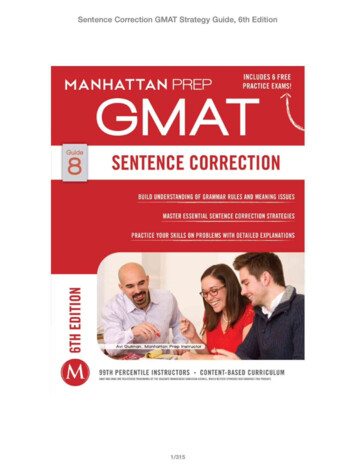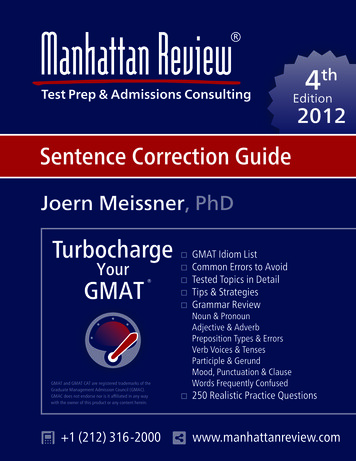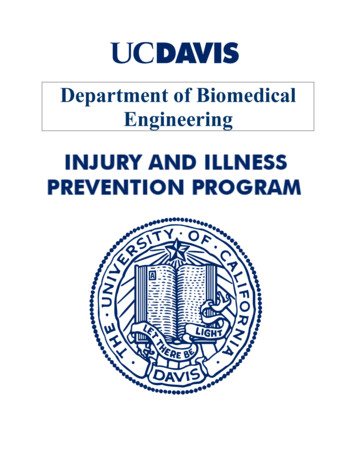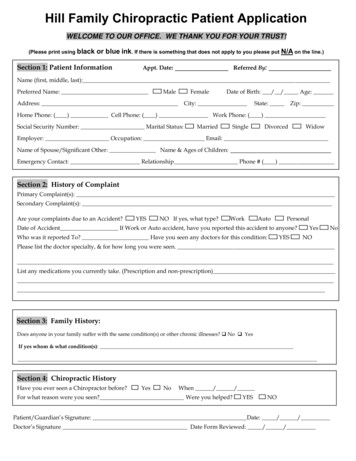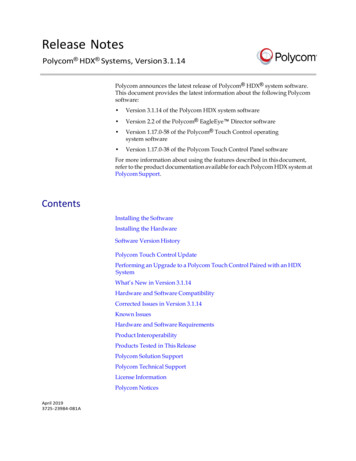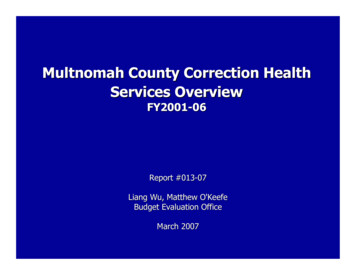
Transcription
Multnomah County Correction HealthServices OverviewFY2001-06Report #013-07Liang Wu, Matthew O'KeefeBudget Evaluation OfficeMarch 2007
Correction Health Services: MedicalScreen, Medical Services Request, andOutside Appointments/TransportsFY2001 – FY20062
Medical Alerts From Health Screen Both the number of positive medical screens and medical alerts as percent of all cases screened increased from 2003 to 2005. It slightly fellback in FY2006 after FY2005’s peak.In FY2005, a total of 35,766 medical alerts were reported. It accounts for68% of all medical screens conducted in a year.Number of Medical Alerts Or Positive Medical Screens4000070%Medical alerts as % of total medical 20063
Psych Alerts Identified from Health Screen The percentage of psych alerts is up since FY2004. Of all medical conditions identified, about 1 in 5 suggested mental health or psychproblems.In FY2006, 6571 psych alerts were issued, accounting for 21% of allpositive medical screens.Number Psych Alerts from Medical Screen30%8000Psych alerts as % of total medical 520064
Other Medical Conditions Identified Number of Diabetes cases increased steadily for the past five years.Number of Seizures fluctuated from year to year but not back down.No significant change in number of Cardio or HIV positive casesidentified.Number of Medical Alerts For Selected CategoriesSiezure HxDiabetesCardioHIV Positive9007506004503001500200220032004200520065
Medical/Mental Health Infirmary Admission Number of new medical infirmary admissions was the highest in 2005 and number of medical patient days was the highest in 2006.Number of mental health infirmary admissions and number of patient dayshas held steady since 2003.Overall, infirmary admissions and patient days show an upward trend.Medical InfirmaryMental Health InfirmaryYearadmissionpatient dayadmissionpatient 61071789734537826
Medical Request Forms Received The number of medical request forms (MRFs) has been showing anupward trend for the last five years. The increased MRFs were primarily from the adult facilities. TheMRFs from JDH have been flat over the past five years.Number of Madical Requests Forms Received ep-05Jan06May-060* Only include MCDC, MCIJ, and JDH medical request forms.7
Clinic Visits at County Correction Facilities Data reported in the following table include clinic visits conducted at MCDC, MCIJ, and JDH between 2004 and 2006.The total number of provider visits (MD, NP) in 2006 dropped 22% from theprevious year. Ortho visits also decreased by 24%.Mental Health visits (CHN/MHC) slightly increased from Yr 2005 to Yr 2006(4%). The increased visits mainly came from JDH. More visits could also areflective of more accuracy in recording mental health visits recently.There wasn’t much change in number of dental or OB/GYN visits.Clinic Visits at County Correction Facilities (Year 2004-2006)Type of VisitYr 2004Yr 2005Yr 2006Change from2005 to 2006Clinic Visits (providers)847597747611-2163Dental Visits194622852278-7Mental Health Visit*N/A24262526100OB/GYN Visits249252244-8Ortho Visits316267204-63* MentalHealth visits was not well documented in 2004.8
Outside Medical Appointments/Transports There was a 36% overall reduction in outside appointments or transports between 2001 and 2003. The number has been relativelystable since then.MCIJ’s sharp decrease in utilizing the outside appointment/transportservices during 2003 contributed to the overall reduction.Number of Outside 5002001200220032004200520069
Ambulance Transports & Hospital Admissions The number of ambulance transports substantially decreased in 2002. The year of 2004 and 2005 had the lowest number of ambulance transports.However, there was a 31% increase in 2006 over the previous year.Hospital admissions increased significantly from 74 in 2005 to 108 in 2006.Yr 2006 admissions was the second highest over the past 6 years. Numberof patient days at Portland Adventist Hospital also increased from 150 daysin 2005 to 209 days in 2006.Number of Ambulance Transports and Hospital Admission*160160# of Hospital admissions12012080804040# of Ambulance Transports00200120022003200420052006* Hospital admission count includes admissions to Portland Adventist Hospital and OHSU.10
Summary of Inmates Medical Services Inmate medical needs have increased over the past five years, assuggested by the increasing in number of positive medical screens andnumber of medical request forms filled by the inmates. Medical and mentalhealth infirmary admissions and patient days hold steady. The number of identified severe medical conditions such as Diabetes,Seizure, Cardio, and HIV positive either increased or maintained at similarlevel for the past five years. Outside appointment/transport and ambulance transports fell substantiallyaround 2002 and 2003. But the trend was reversed in 2005, which showedan increase in ambulance transports and outside appointment from 2005. The number of Hospital admissions and Portland Adventist patient bed daysshowed a substantial increase in 2006 over 2005. In-house clinic visits data for the past three years indicate a cut-back ofprovider visits in 2006, reflecting FY2006 cuts in provider capacity, staffshortage, and program redesign. Yr 2006 also saw a significant decrease in number of TB screens or lab testsperformed due to recent procedure change. Currently, every inmate will getscreened but only identified high-risk inmates are targeted for testing.11
Correction Health Adopted Budgetsand Actual ExpensesFY2001 – FY200612
Correction Health Adopted Budget and FTE Correction Health adopted budgets were relatively flat between FY2002 and FY2005. It went up in FY2006 but got cut back in FY2007 to the priorFY2006 level.The adopted FTE experienced reduction between FY2002 and FY2004. Itstabilized between FY2004 and FY2006. Another cutback occurred inFY2007(data not shown here), which funds a staffing level at approximately70% of FY2002 budgeted FTE (from 120.2 FTE in FY02 to 82.3 FTE inFY07).Correction Health Adopted Budget and FTE 16,000,000160# of Adopted FTE120 12,000,00080 8,000,00040 4,000,0000FY2002FY2003FY2004FY2005FY200613
Actual Expense and Spending per Jail Bed Overall correction health actual expenditures started to fall in FY2003 but has been moving up since FY2004.If dividing the expense by average number of budgeted jail beds in a fiscalyear (including jail beds at Juvenile Detention Center), expense per jail bedhas been steadily increasing since FY2004.Estimated correction health spending on per jail bed basis increased 5.8%in FY2006 over FY2005.Correction Health Actual Expenditures 10,000 16,000,000Expenditure per jail bed 8,000 12,000,000 6,000 8,000,000 4,000 4,000,000 2,000FY2001FY2002FY2003FY2004FY2005FY200614
Correction Health Cost Per Inmate Per Day* If dividing the total expenditures by total number of jail bed days, the cost per inmate per day has been increasing since FY2004.Cost per inmate per day in FY2006 was 23.51. It jumped 7.1% overthe cost of FY2005.Correction Health Cost Per Inmate Per DayNumber of jail bed days750000 25Cost per bed day600000 20450000 15300000 101500000 5FY2002*FY2003FY2004FY2005FY2006Does not include jail bed days at Juvenile Detention Center.Center. Historic data for jail bed days at juvenile detentioncenter were not available at this time. The cost per inmate per day should be lower if juvenile data wereincluded. According to the Health Dept., the average correction health cost per bed day at JDH is 17.95 forFY07 budget.1515
Actual Expenses by Category FY2004 had the highest percent of personnel spending (75.2%). Percent of personnel spending dropped to 67.2% in FY2006.There was a 29.7% increase in amount spent on external or contractedmedical services in FY2006 over FY2005. Not much increase was foundin medical supplies and drugs spending over the past six years.Correction Health Expenditures by CategoryPersonnelInternal Service & Indirect ChargesMaterial & SuppliesExternal or Contracted MedicareMedical Supplies and Drugs 14,500,000 12,000,000 9,500,000 7,000,000 4,500,000 2,000,000FY2001FY2002FY2003FY2004FY2005FY200616
Spending on Drugs & Medical Supplies On average, between 7% and 8% of total Correction Health dollarswere spent on drugs and medical supplies. The percent of funds spent on drugs and medical supplies has notchanged significantly although it has been slightly creeping up sinceFY2003.Expenditures on Drugs and Medical SuppliesDrug/medical supplies as % of total correction health spending9.0% 1,200,000.00 900,000.006.0% 600,000.003.0% 300,000.00 0.000.0%FY2001FY2002FY2003FY2004FY2005FY200617
Spending on Professional Services FY2003 had the lowest of professional service expenses over thepast five years. A sharp increase in amount of funds spent onprofessional services was observed in FY2006. Professional services as percent of total correction healthexpenditures increased from 11.9% in FY2001 to 15.9% in FY2006.Expenditures on Professional Services18.0% 2,500,000Professional services as % of total correction health spending15.0% 2,000,00012.0% 1,500,0009.0% 1,000,0006.0% 500,0003.0%FY2001FY2002FY2003FY2004FY2005FY200618
Example of FY06 Professional Services Spending* In FY2006, the County paid approximately 2,216,639 for medical servicesprovided by community providers. The top payees were Adventist Medical Group (37%), OHSU MedicalGroup/Hospital(25%), and Providence Portland (8%). Other health providers, such as Legacy Hospital, CEP Portland, FMC NEPortland, and American Medical also received payment ranged from 40,000 to 70,000 from the services. Based on available invoice data, it was estimated that the external costrelated to diagnostic radiology was 40,722, anesthesia was 41,992, anddental services was 16,912.*Please treat this data with caution. These invoices were not paidthey were paid through a thirdpaid out of SAP-SAP--theythird-party(UHN) and the payments are then entered into SAP via an upload fromfrom a file provided by the Health Department.19
FY2007 Correction Health Expenditures From July to February 2007, the actual expenses were 8,685,200. Professional or contracted medical services continue to grow. It accounts for 19.7% of total money spent so far, well beyond 15.9% reported inFY2006Spending on drugs and medical supplies also slightly increased from 8.0%in FY2006 to 8.2% of total expenditures during the first eight months ofFY2007FY07 Expense by Category (Jul. 07-Feb.07)PersonnelMedical Supplies and DrugsInternal Service & Indirect Charges 900,000External or Contracted MedicareMaterial & Supplies 750,000 600,000 450,000 300,000 150,000 0JulyAugSepOctNovDecJanFeb20
Summary of Correction Health Expenditures Huge increase in external medical service cost over the past six years.External services costs as percent of total correction health expendituresincreased from 11.9% in FY2001 to 19.7% for the first eight months ofFY2007. Further examination of the driving forces behind jumps of externalmedical service cost in recent two years is needed. Relatively stable in medical supply and drug cost. It went up at a slow pacefrom 7.1% of total cost in FY2003 to 8.2% for the first eight months ofFY2007. Although with continuous cuts in FTE, percent of budget spent on personnelhas not shown substantial decrease. The data did suggest a shift fromhigher internal personnel cost and lower external profession services cost inFY2005 to a lower internal personnel cost and higher external professionservice cost in FY2006. If dividing actual expenses by number of jail beds or number of bed days,both cost per jail bed and per jail bed day have shown noticeable increasesince FY2004.21
Characteristics of Top 52High-Cost Professional Services UsersCY2005 - CY200622
Top Professional Service Costs Users for CY 2005-2006:Top Users The average Top User is older (41 years vs. 34 years), in jail more frequently(2.8 vs. 1.7 bookings) and for longer (72 days vs. 21 days ) than the averageperson booked during this period. Six individuals, or 12% of the top users group, incurred 38% of the totalprofessional services costs for the top users group. Fourteen individuals, or 27% of the top users group, occupied 42% of the totaljail bed days for the top user group.Professional Services Top User Characteristics CY05-06Total JailBed DaysCY05-06Average Lengthof Stay perCustody (Days)AverageNumber ices Costs(CY 05-06)TotalProfessionalServices Costs(CY 05-06)Top Users Group (n 52)9,677722.841 26,445.64 1,295,836.17Users w/ ProfessionalServices Costs 50K(n 6)1,35075340 74,545.68 492,432.90Users w/ 5 Custodies(n 10)1,56026639 28,078.74 280,787.41Users w/ ALS 60 days(n 14)4,1221841.642 26,572.63 372,016.8323
Top Professional Service Costs Users for CY 2005-2006:Top Users 51% of the Top User group was booked for ‘Other’ type crime. 30% of ‘Other’ category crimes were from Parole Violations. 27% of ‘Other’ category crimes were County Holds. 23% of ‘Other’ category crimes were Post Prison Supervision violationsTop Users: Crime Type for CY 05-0680Other Charge(n 69)70# of Charges605040Person(n 21)3020100Alcohol & Drugs(n 9)Behavioral(n 6)Local(n 4)Property(n 15)Vehicle(n 9)24
Top Professional Service Costs Users for CY 2005-2006:Top Users The group w/ professional services costs 50K represented 14% of total primarycharges and 16% of county hold charges The group w/ 5 custodies represented 44% of total primary charges, 56% of postprison supervision violations, 42% of county holds, and 100% of burglary charges. The group with an ALS 60 days represented 16% of total primary charges, 65% oftotal assault and attempted murder charges, and over 90% of sex related charges.Top Users: Primary Charges t PrisonSupervisionViolationCountyHoldDUIIBurglary 1UnauthorizedUse of a MotorVehicle133211619766Users w/ ProfessionalServices Costs 50K(n 6)181x31xxUsers w/ 5 Custodies(n 10)59x98x64Users w/ ALS 60 days(n 14)22x151xxTop Users Group (n 52)25
Summary of Characteristics of Top ProfessionalService Costs Users for CY 2005-2006 On average, this group commits more serious offenses, goes to jailmore often, stays in jail longer than the typical person in jail. Individuals w/ a professional services charge over 50K represented16% of County Hold charges, stayed in jail slightly longer, and onaverage incurred professional services charges that are 280% greaterthan the group average. Individuals w/ 5 custodies represented 44% of total primary chargesfor Top User group, had 56% of total PPSV charges, had a 60% shorterlength of stay per custody, and on average incurred professionalservices charges slightly above the group average. Individuals w/ an average length of stay 60 days represented 90% oftotal sex related charges, 65% of total assault and attempted murdercharges, had a 250% longer stay per custody, and on average incurredprofessional service charges slightly above the group average.26
Discussion: Why the rise of correction health cost?Preliminary results from the past five years’ data indicate that the Countycorrection health cost per budgeted jail bed or per inmate per bed day isincreasing. A literature review of correction health cost suggests thatfollowing reasons have contributed to the rising cost of correction health,especially the cost associated with external medical services:– Rise in CPI (impact on staff/personnel cost)– Inflation in the medical service industry (impact on external medical treatmentcost)– The general aging of the inmate population (increase inmate medical care needs)– The increase in the number of inmates with severe medical conditions (increasehospital admission and bed days)Over the past a few years, the inmates health treatment needs at Countycorrection facilities have not shown declining as suggested by followingevidences:– # of bookings and housed inmates has not slowed down although average lengthof stay reduced– # of medical request forms filed has increased– No decrease in # of inmates who had major medical conditions such as HIV,Mental illness, Diabetes and Seizures– # of ambulance transportations has increased since 2004– Increase in # of inmates who were over 50 years old27
Discussion: What policy questions we should ask?The raising costs in County Correction Health mirror a national trend. Here aresome exploratory questions based on the preliminary data we gathered: How to mitigate increasing Professional Service charges?– Mix of service providers: are there some medical conditions that can be costeffectively treated in house vs. out of house, and vice versa?– Are we paying market rate for these services? Can we negotiate rates comparableto Medicare/Medicaid rates?– Is it more cost-effective to develop in-house treatment capacities than extensivelyusing community providers? How do we balance public safety concern with cost containment effort?– Can we handle the stream of offenders w/ mental illness differently?– Can we keep high cost individuals out of jail without jeopardizing the publicsafety?– Can we find ways to reduce custodies or shorten the number of bed days for thosebooked for ‘Other’ charges, such as other County holds and parole violations? Topics for further investigation:– How does lack of health insurance/preventative medical care in the generalpopulation effect the health of the inmate population?– Can we purchase insurance that protects us from high risk/high cost individualswith catastrophic injury/illness?28
Data Sources and Limitations of AnalysisData Sources: Correction Health and certain financial data were received from Health Department.Correction Health budget data were retrieved from SAPDatabase.Limitations: Time and disclosure restrictions prevented collection of additional Corrections Health data.Only limited literature review of national correction health systemand cost containment efforts were performed.Health costs per budgeted jail bed or per inmate bed day wereonly coarsely estimated. A more rigorous cost analysis is neededin the future.29
6 Medical/Mental Health Infirmary Admission Number of new medical infirmary admissions was the highest in 20 05 and number of medical patient days was the highest in 2006. Number of mental health infirmary admissions and number of patie nt days has held steady since 2003. Overall, infirmary admissions and patient days show an upward trend. 2006 1071 7897 345 3782

